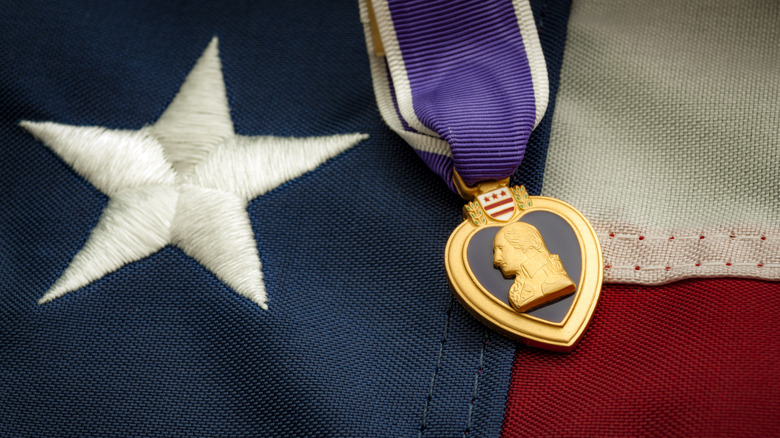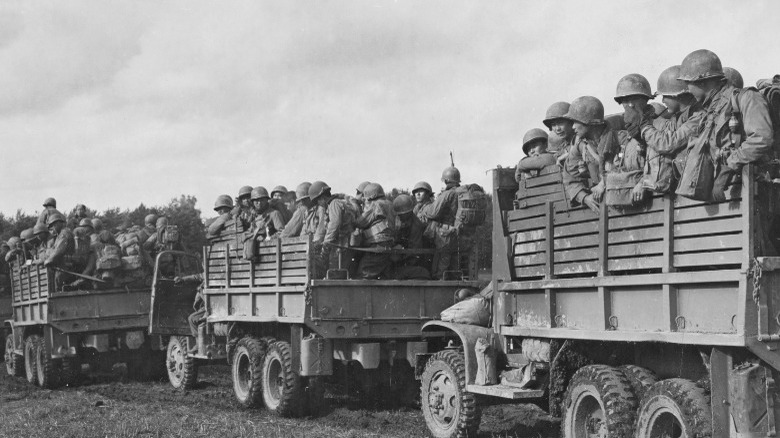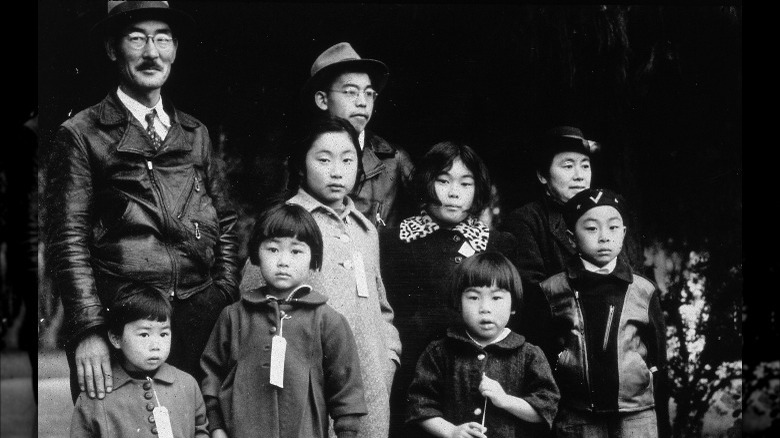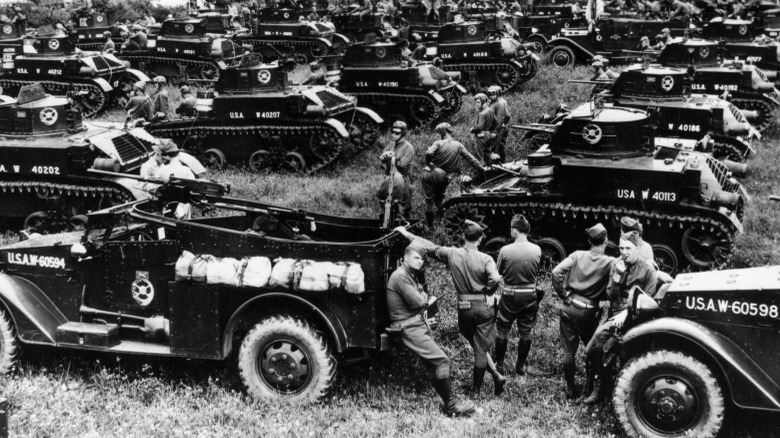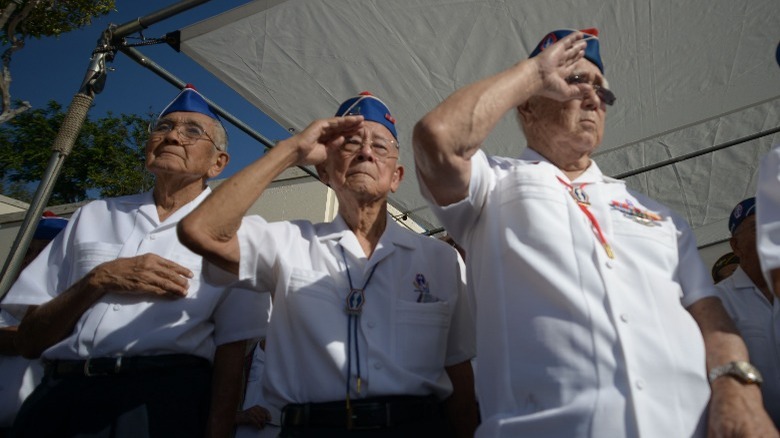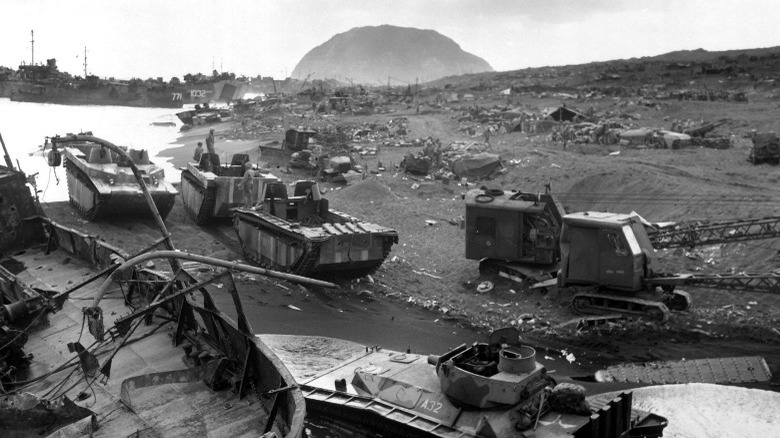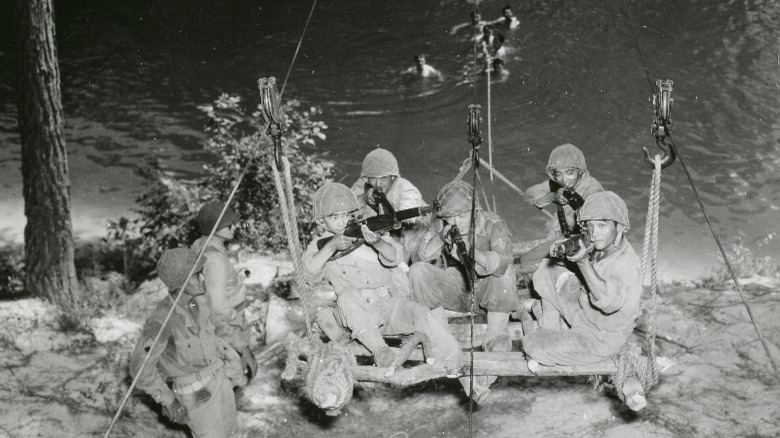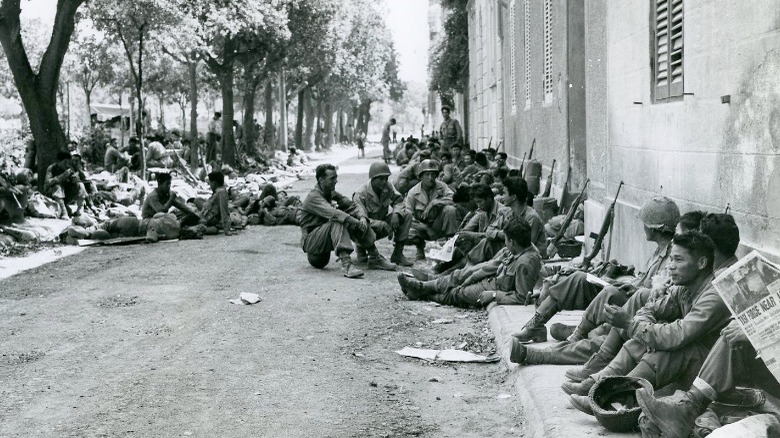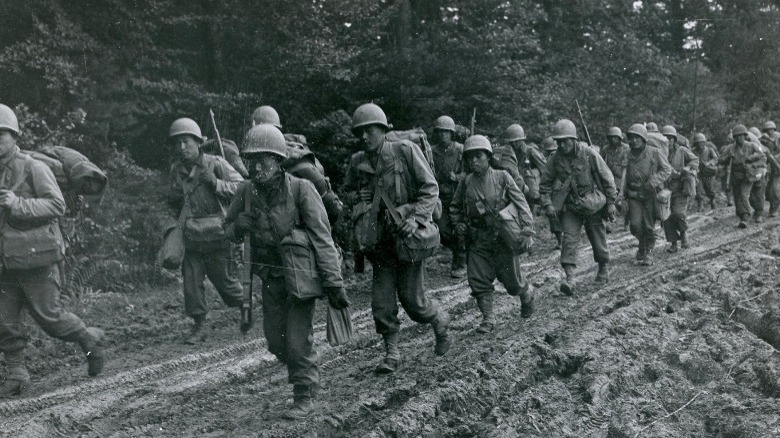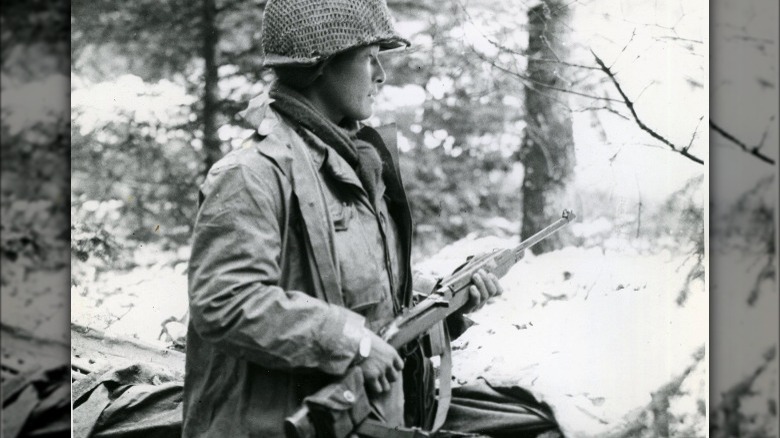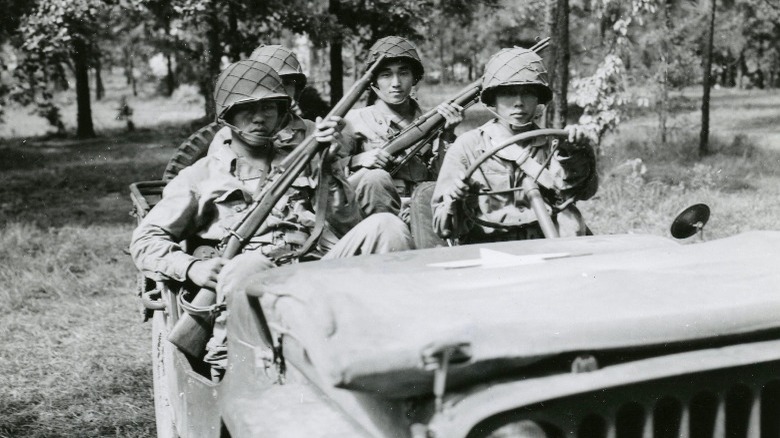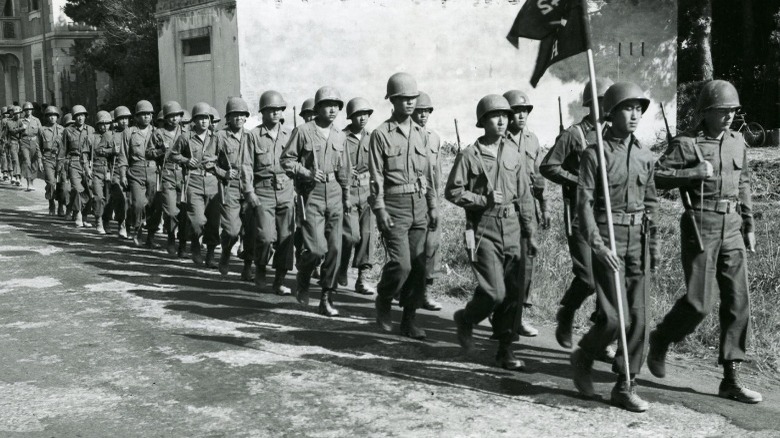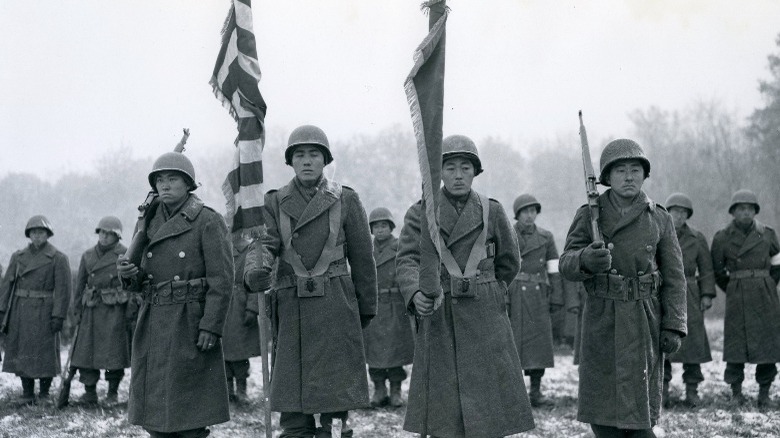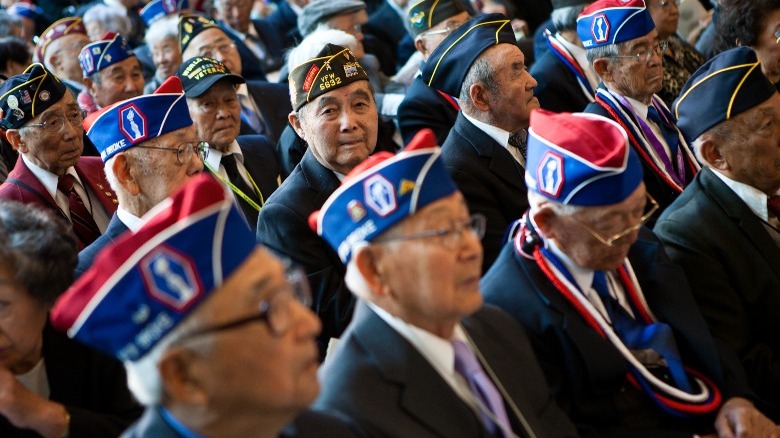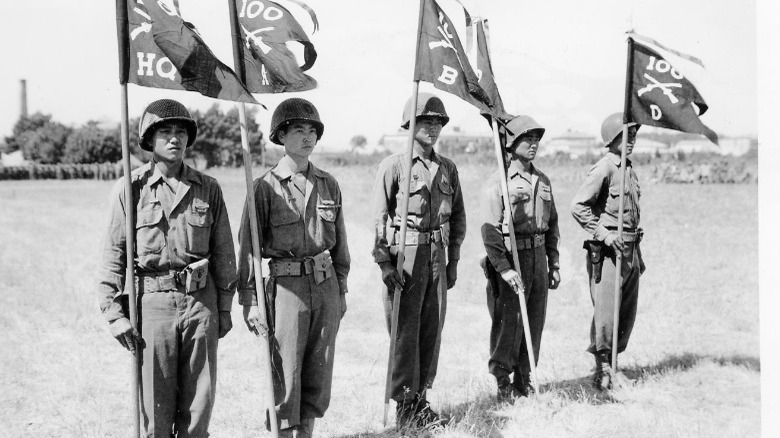The Tragic True Story Behind The Purple Heart Battalion
World War II was one of the most traumatic events in modern world history. While statistics can never tell the whole story, according to the National WWII Museum, there were approximately 40 million battle casualties, and between 45-100 million civilians died worldwide. Sixteen million Americans served in the armed forces at some point in the war, and just shy of half a million made the ultimate sacrifice and lost their lives defending freedom and human rights (per the National Parks Service).
Japanese-Americans made up roughly 33,000 of the American servicemen in WWII, and many of them served in the 442nd Regimental Combat Team or 100th Infantry Battalion (via the Arlington National Cemetery). Both units were made up exclusively of Japanese Americans, primarily Nisei (second generation), many of whom had family members who were interned while they were serving in the army overseas. Though they were originally separate units — with the 100th Battalion forming in June 1942 and the 442nd Regiment forming the following February — they integrated together in August 1944 and fought alongside each other for the remainder of the war (per the National WWII Museum). They are now known collectively as the Purple Heart Battalion because of the incredible amount of casualties sustained by each unit's soldiers. They leave a legacy of true patriotism and heroism, serving a country in which they were not even considered equals. This is the tragic true story behind the Purple Heart Battalion.
Many Japanese Americans were kicked out of the army in 1942
At the time of the attack on Pearl Harbor on December 7, 1941, there were many Nisei (second generation) Japanese Americans on the island serving in the University of Hawaii's Reserve Officer Training Corps — the Hawaii Territorial Guard. They helped in the aftermath of the bombing by rendering aid to wounded sailors and clearing away debris (via the Go For Broke National Education Center). However, just a month later, on January 19, the army disbanded the guard with no explanation. Then, the following day, the army reformed the guard — however, none of the Nisei were allowed to join.
An 18-year-old former corporal in the guard, Yoshiaki Fujitani, later said (via the University of Hawaii) that the Nisei recruits felt "angry, disappointed. I think maybe we cried, too ... we had no intention of being traitors to America but already we're being suspected and they're not trusting us."
The following month, the army formed a civilian unit known as the "Varsity Victory Volunteers" (per the University of Hawaii). The volunteers were made up of mainly former cadets in the guard, and they did hard work, including building roads, buildings, and fences, for the army. When the army formed the 442nd Regimental Combat Team in January 1943, many volunteer members quickly signed up and joined the unit and subsequently fought in the war. Afterward, many of them returned to the university to get their degrees (per the 100th Infantry Battalion Veterans Education Center).
Many had interned families, and some staged a failed protest
Soon after the attack on Pearl Harbor, Japanese Americans immediately came under a cloud of suspicion. Those who had previously registered with the selective service (but who were not enlisted) were reclassified from eligible to "IV-C enemy alien" status on January 5, 1942 (via the National Parks Service). They were allowed to register for service again starting in January 1944. However, that coincided with the public release of the 100th Infantry Battalion's casualties in Europe. According to Masayo Duus in "Unlikely Liberators: The Men of the 100th and 442," authorities were worried it "might lead to the interpretation that the reinstitution of selective service was designated as an 'exterminating measure' against Japanese Americans." And it is true that the segregationist policies of the army at the time did drive them to need more Japanese American recruits to replenish the casualties in the Purple Heart Battalion.
When the prohibition on the selective service was abolished, 600 Nisei draftees began training as replacements. After just a few months of training and years of discrimination and racism, several of them staged a protest and refused to continue drilling. They did so out of fear for their interned family members, and they demanded assurances that their families would be safe and secure if they fought overseas. Army authorities quickly quelled the rebellion, and 28 were eventually given dishonorable discharges — which were only corrected in 1982. The rest went to Europe to restrengthen the 100th and 442nd.
They were segregated within the army
It might seem surprising to younger readers, but shamefully, there was a time in the United States when the armed forces were not fully integrated. According to the Air Force, Black Americans have fought in every conflict since the American Revolution, but it was not until after the Korean War that segregation was completely abolished from the U.S. military. Both the 442nd Regimental Combat Team and the 100th Infantry Battalion were segregated units during WWII (via History).
Both units' men were composed of Nisei Japanese Americans, but the officers of the units were white. The 100th Battalion consisted of more than 1,400 troops (via the National WWII Museum), and the 442nd Regiment had over 10 times as many (per the National WWII Museum). However, just because the units themselves were segregated doesn't mean they only fought alongside only Japanese American units. The 100th Battalion first saw action during the Italian campaign, and they were attached to the non-Nisei 34th Division's 133rd Regiment (via the 100th Infantry Battalion Veterans Education Center). Incredibly, the 442nd also fought alongside the famous 92nd Infantry Division, another segregated unit made up solely of African American soldiers (per the National WWII Museum).
The story of their slogan 'Go for Broke'
Serving in the armed forces must have been difficult for many of the soldiers in the 442nd Regimental Combat Team and the 100th Infantry Battalion. Not only did they have the stress of training and being at war, but they also had to fight knowing they were not considered equals back in America because of their skin color and ancestry. When the 100th Battalion formed in June 1942, they came up with the slogan "One Puka Puka," which roughly translated to "100th Battalion" in Hawaiian (per the National WWII Museum). A year later, in August 1943, the men adopted another slogan, "Remember Pearl Harbor." This was especially personal to the battalion because many of them had been serving in the Hawaiian National Guard during the attack and had helped render aid to wounded sailors.
When the 442nd was formed in early 1943, they came up with the slogan "Go for Broke" (per National WWII Museum). Their slogan, similar to "One Puka Puka," was also derived from Hawaiian and referred to a gambler risking everything they had to win a big pot. "Go for Broke" had a double meaning for the Nisei soldiers, as they were fighting not just against the Nazi war machine but also against racial prejudice in America. When the 100th Battalion joined the 442nd in 1944, they kept their slogans but also adopted "Go for Broke" as a sign of respect for their 442nd brothers and their shared struggles.
There was serious tension within the 442nd
The 442nd Regimental Combat Team was composed exclusively of Nisei Japanese American soldiers who were recruited both from Hawaii and the continental United States. When the government announced the creation of an exclusively Nisei regiment in early 1943, there were 10,000 volunteers from Hawaii alone (via the Go For Broke Education Center). However, in a reflection of the devastation and anguish caused by the internment order against Japanese Americans, there was a nearly 90% reduction in the number of volunteers from the mainland, and only 1,182 signed up.
Almost immediately after the regiment was formed, tension broke out between those who were from Hawaii and those from the mainland. The Hawaiians were nicknamed "Buddhaheads," and the mainlanders were known as "Kotonks." According to Masayo Duus in "Unlikely Liberators," much of the hostility came from the fact that many of the non-commissioned officers were Kotonks and draftees, whereas most of the Buddhaheads were enlisted men who had volunteered. The Buddhaheads did not appreciate being ordered around by mainlanders, even though they were relatively fair. Hawaiian recruits frequently attacked the mainlanders by surprise, and fights could break out about anything. Per "Unlikely Liberators," Hawaiians complained the mainlanders did not "have the initiative like the Hawaiians ... Their heart is small," whereas the "Kotonks" considered the Hawaiians to be "barbarians from the jungle." However, the men were able to patch up their differences and fight together as a team.
They were shocked by the Jim Crow racism at their training camp
When the 442nd Regimental Combat Team was training for war, they did so at Camp Shelby, Mississippi, starting in April 1943 (via Masayo Duus in "Unlikely Liberators"). Already training at Shelby at the time was the 100th Infantry Battalion, who had arrived months earlier in January. Over 100,000 American troops did their training there during the war.
Members of both the 442nd Regiment and 100th Battalion frequently went to Hattiesburg, Mississippi on pass because it specifically catered to American G.I.s with its lively nightlife scene. However, when many of the soldiers got to Hattiesburg, they were shocked by what they saw. It was still the era of Jim Crow laws in Hattiesburg, and though they tried to ignore it, the racism perpetrated against African Americans deeply penetrated their hearts and upset them. The Nisei were treated as white men by most of the people in the town, but this was a "convenient hypocrisy adopted to keep trouble from starting."
Many of the Nisei challenged the racial segregation laws by using "colored" facilities and sitting in the backs of buses. One of them told a bus driver, "Look at my face. It's not white ... It's close to black." Shockingly, one colonel even told the 100th Battalion before their arrival, "There is no way you boys are going to break down the southern way of doing things," and encouraged them not to be "friendly" with local African Americans.
The 100th Battalion helped liberate Rome but faced heavy casualties
After 15 months of hard training since their original activation in June 1942, the 100th Infantry Battalion was going to war. According to an official U.S. Army publication, the battalion landed in Oran, North Africa, before immediately participating in the now-famous Allied landings at Salerno. They had their first action in Montemarano a few days later before pushing further north through Bagnoli and passing the Volturno River in mid-October — on the way toward Rome. During a battle at St. Angelo d'Alife, the battalion incurred many losses, with 21 killed and more than 60 wounded.
In early January of the following year, the 100th found itself on the banks of the Rapido River at Monte Cassino hill. The battalion engaged in heavy fighting with the German army at Cassino, with the Americans relentlessly attacking the famous monastery on the mountain. After several days of failed attacks, the battalion pulled back; 48 men and officers had died, over 140 were wounded, and two were taken prisoner by the enemy.
Later in March, replacements from the 442nd Regimental Combat Team, still training at Camp Shelby, were called up to reinforce the diminished 100th at Anzio. At the Battle of Lanuvio, the 100th helped open the road to Rome, but at the cost of another 15 killed and 63 wounded. Once in Rome, the 100th finally integrated with the 442nd as the new First Battalion.
The horrible fighting conditions
Making the already intolerable conditions of fighting even worse was the horrible weather. During the Battle of Bruyères in the Rhineland campaign, the 442nd Regimental Combat Team and 100th Infantry Battalion faced some of the most extreme weather during their tours. According to an official U.S. Army publication, it was constantly raining during the fighting, and the enemy artillery made the roads impassable at times. The heavy strikes brought down trees and left shrapnel littered throughout the area.
After bouts of intense shelling, there would be death traps of tangled logs, mines, and wires, and the 232nd Combat Engineer Company had to clear them away. Later in the campaign, the engineers had to lay miles of logs and planks through a "sea of mud" so the troops could get through. According to Orville C. Shirley in "AMERICANS: The Story of The 442d Combat Team," the combination of rough terrain and "cold, penetrating rain, lowered the men's morale more than anything the Germans could do."
When they arrived at Bruyères, many of the men were still in their summer uniforms, and some had to ride on trains that smelled of horse manure (via History). Heavy fog and thick natural vegetation severely curtailed how far away the soldiers could see, which partly contributed to their slow progress, and they were moving barely 500 yards a day at first. There were so many dead in the streets the soldiers had to resort to using a bulldozer to clear a path.
Saving the Lost Battalion
One of the most heroic battles of WWII, the Battle of the Lost Battalion, was also one of the deadliest for the men of the Purple Heart Battalion. According to History, the famous battle took place near the French towns of Bruyères and Biffontaine in the Vosges mountains. The mission started on October 15, 1944, and just over a week later, both towns had been liberated. The battalion was relieved to get some rest, but quickly, a crisis struck. One of their relief units — the 1st Battalion, 141st Regiment of the Texas National Guard — had become trapped by Nazis and isolated from their other units. On October 26, the Purple Heart Battalion was called upon to rescue the now desperate Texans (per "AMERICANS").
They tried to push through the German defenses, separating them from the Lost Battalion, but the Nazis consistently held firm against their attacks. In one of the most courageous acts, Staff Sergeant Gordon Yamashiro pushed forward by himself, and he took out two machine gun crews and a sniper before succumbing to another sniper's bullet. Yamashiro was posthumously awarded the Distinguished Service Cross for his sacrifice and heroism. The Germans were still holding strong, but casualties were mounting, and on October 29, they lost at least 350 men to the battle (via "AMERICANS"). After a final artillery barrage, the Purple Heart Battalion finally broke through and made contact, but at the cost of over 800 casualties during the campaign (via History).
They helped liberate the Dachau concentration camp
In March of 1945, the 522nd Field Artillery Battalion was officially separated from the larger 442nd Regimental Combat Team, and they were sent to the Lorraine region in northern France to help with operations there (via the Go For Broke Education Center). They broke through the Siegfried Line and crossed the Rhine, filling in up and down the front lines wherever they were needed. By late April, they were moving towards Aub, Germany, on the way to Berlin.
On April 29, while on patrol 30 miles east of Munich, the 522nd witnessed one of the most horrifying sights of the entire war — an area encircled with barbed wire and full of dead or emaciated prisoners. It was a Nazi death camp, most likely Kaufering-Lager IV Hurlach, one of the several smaller sub-concentration camps part of the infamous Dachau concentration camp. The soldiers walked over "lumps in snow" — not realizing they were the dead bodies of prisoners (via The Washington Post). Some of the Nisei tragically drew comparisons between the internment camps their parents were in and the same camps they were "liberating." Incredibly, years after the war, a Nisei veteran and a Jewish survivor from Kaufering reunited in California. That began a lifelong friendship between them, and it was the subject of the play "The Gate of Heaven," which was written in the 1990s.
They almost had to keep fighting in the Pacific
The war in Europe finally came to an end on May 9, 1945, and the Purple Heart Battalion was relieved to be done with the killing and devastation of the previous years. However, though the war was over, they still spent time rounding up the small bands of Wehrmacht soldiers that were scattered throughout their section of northern Italy (per "AMERICA"). They also started the arduous task of helping process the hundreds of thousands of prisoners and civilians — both friendly and not. Finally, on May 31, the first 38 members of the battalion were eligible to be discharged and sent home.
After a month of processing surrendering German and Italian soldiers, on June 14, the 442nd was briefly designated for "an extensive army education and recreation program" in northern Italy (via "AMERICA"). However, they were quickly reassigned to potential action in the Pacific theater, and they started a full training program in Lecco and Leghorn, Italy. Some of the veterans had fought in four campaigns by this point and were about to be asked to do even more for their country.
Thankfully, the war in the Pacific came to an end on September 2, 1945, and so did WWII. The 442nd marched in the Victory over Japan Day parade in Leghorn that day, heading a group of 15,000 other Allied troops. They continued to monitor the POW camps in the area for months, but by then, the fighting was finally over.
The entire battalion combined for over 9,400 Purple Hearts
You don't get a nickname like the Purple Heart Battalion for nothing, and the members of the 100th Infantry Battalion and 442nd Regimental Combat Team more than earned the distinction. According to the National WWII Museum, the Purple Heart Battalion had a combined casualty rate of an incredible 314% during the war. Twenty-one individuals were awarded the Medal of Honor, and 29 were awarded the Distinguished Service Cross. Fifteen were awarded the Soldier's Medal, which — per the Go For Broke Education Center — is given for acts that "involved personal hazard or danger and the voluntary risk of life under conditions not involving conflict with an armed enemy."
Astonishingly, 9,486 Purple Hearts were awarded to the units combined, and they are earned by being wounded in battle. The battalion's name derives from this incredibly high number of Purple Heart awards and also from the 100th Battalion's heroic but tragic performance during the Battle of Monte Cassino in early 1944 — which resulted in high casualties. The Purple Heart Battalion was also awarded seven Presidential Unit Citations, and in 2011, they were finally awarded a Congressional Gold Medal.
They faced extreme racism from the public when they came home
Even though the Japanese American soldiers in the Purple Heart Battalion had gallantly served their country, they still faced large amounts of xenophobia and racism back home. According to Masayo Duus in "Unlikely Liberators," once the men returned from the war, they were still treated like second-class citizens. Many of the Nisei who lived on the West Coast had parents who were still living in internment camps, and several returning veterans came to live with them — as decorated war heroes — in the informal prisons.
Throughout the coast and especially in California, Japanese American veterans experienced, at times, violent instances of discrimination. In some cases, they were denied entrance to restaurants and barbershops. Other times, their houses were subjected to arson attempts and shootings. Families of veterans who tried to return to their former homes faced similarly harsh experiences. One family, the Masudas, experienced continuous death threats. It was not until a general from the army came out to honor their late son by publicly giving them his Distinguished Service Cross that the family was given any sympathy from neighbors. Many veterans also had trouble finding employment upon their return from war due to discrimination from employers.
No official apology until 1988
After the war, the Japanese American veterans of the 100th Infantry Battalion and 442nd Regimental Combat Team just wanted to come home and live a life of peace. Many of them came home bursting with pride and honor, and they had newfound self-confidence from their grueling experiences in the war (per Masayo Duus in "Unlikely Liberators"). Yet, the U.S. government still did not seem to see it that way. It was not until 1952 that the parents of many in the Purple Heart Battalion were allowed to become naturalized American citizens. Their sons had served, and many of them had been killed or severely wounded, but they were not considered eligible to be American citizens for nearly a decade after the war.
In 1988, over four decades after the internment policy was initiated and ended, the federal government finally made an official apology. Signed into law by President Ronald Reagan, the Civil Liberties Act officially apologized for the devastating and racist internment camps, and it implicitly recognized the contributions of the many Japanese Americans who fought in the war for the Allies (via Britannica).
